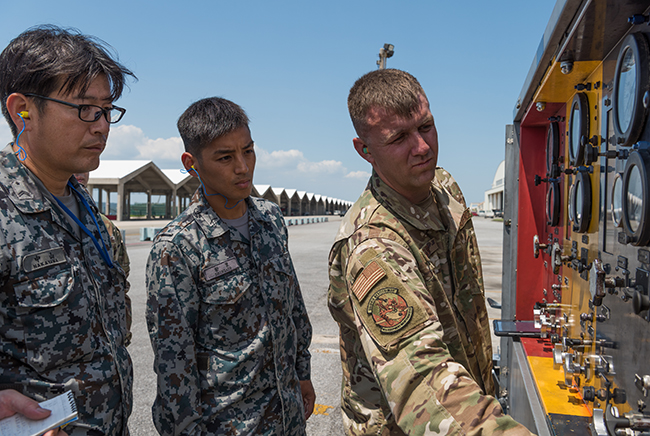
USAF TSgt. Adam Decker, south aerospace ground equipment section chief assigned to the 18th Equipment Maintenance Squadron, demonstrates how to use the hydraulic test stand during a bilateral training exercise with the Japan Air Self-Defense Force on May 23, 2019, on Kadena AB, Japan. Air Force photo by A1C Cynthia Belío.
The Indo-Pacific is the Defense Department’s “priority theater,” but the US military’s advantage over countries such as China and Russia—which are looking to increase interest and influence in the region—is “eroding,” forcing the department to re-evaluate its posture and strategic objectives in the area and placing an even greater emphasis on strengthening partnerships, according to DOD’s first Indo-Pacific strategy report.
“A negative shift in the regional balance of power could encourage competitors to challenge and subvert the free and open order that supports prosperity and security for the United States and its allies and partners,” reads the report. “To address this challenge, DOD is developing a more lethal, resilient, and rapidly innovating Joint Force, and is increasing collaboration with a robust constellation of allies and partners.”
In order to better prepare the joint force, DOD plans to modernize advanced training facilities at the Joint Pacific Alaska Range Complex “to present a more realistic and representative training environment;” improve unit and depot maintenance as it works to reach former Defense Secretary Jim Mattis’ 80 percent readiness target; and it’s investing in advanced missile defense systems that are compatible with Japanese and Australian systems.
The department also plans to purchase a total of 110 fourth- and fifth-generation aircraft to improve capability and capacity across the force, as well as 400 Advanced Medium-Range Air-to-Air Missiles, 400 of the extend-range Joint Air to Surface Missiles, as well as additional Long Range Anti-Ship Missiles and Maritime Strike Tactical Warfare Tomahawks for the US Navy.
The strategy calls for additional resources to support offensive and defensive cyberspace operations, and “efforts to unify, focus, and accelerate the development of space doctrine, capabilities, and expertise to outpace future threats, institutionalize advocacy of space priorities, and further build space warfighting culture.”
Today there are more than 370,000 airmen, soldiers, sailors, and marines operating in the theater, along with more than 2,000 aircraft and 200 ships and submarines. However, a significant number of these forces are operating from Japan, South Korea, and Guam. The strategy calls on DOD to evolve its posture and further distribute its presence and access to other locations throughout the theater.
“In order to overcome the tyranny of distance, posture that supports and enables inter- and intra-theater logistics must be flexible and resilient, and the pre-positioning of equipment is critical,” states the report.
In addition, the department is “exploring expeditionary capabilities,” such as:
- Dynamic basing of USAF and maritime forces
- Special Operations Forces that can conduct both irregular and unconventional warfare
- Cyber and space teams well versed in multi-domain operations
- “Unique intelligence, surveillance, and reconnaissance capabilities”
- Anti-submarine capabilities.
The United States continues to strengthen existing alliances with Japan, South Korea, Australia, the Philippines, and Thailand, while looking to expand partnerships with Singapore, Taiwan, New Zealand, Mongolia, and India. The strategy notes the department also hopes to pursue emerging partnerships with Sri Lanka, the Maldives, Bangladesh, and Nepal, as well as security relationships with Vietnam, Indonesia, and Malaysia.
In his speech at the IISS Shangri-La Dialogue on June 1, Acting Defense Secretary Patrick Shanahan outlined the new strategy and emphasized the United States’ commitment to the region, but he also called on allies and partners to invest more in their own defense and the defense of the region.
”The Indo-Pacific is our priority theater,” he said. ”We are where we belong. We are investing in this region. We are investing in you, and with you, and we need you to invest further in yourselves. We need you to invest in ways that take more control of your sovereignty and your ability to exercise sovereign choices.”